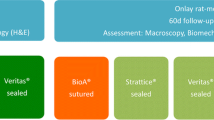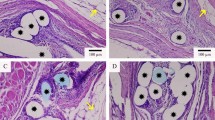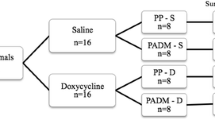Abstract
Background
Formation of recurrent inguinal and incisional hernia shows an underlying defect in the wound healing process. Even following mesh repair an altered collagen formation and insufficient mesh integration has been found as main reason for recurrences. Therefore the development of bioactive mesh materials to achieve a local modification of the scar formation to improve patients outcome is advisable.
Methods
Thirty-six male Wistar rats were used within this study. A Mersilene ® mesh sample was implanted after midline skin incision and subcutaneous preparation. Before implantation mesh samples were incubated for 30 minutes with either one of the following agents: doxycycline, TGF-beta 3, zinc-hydrogeneaspartate, ascorbic acid, hyaluronic acid. Incubation with a physiologic 0.9 % NaCl solution served as control. Seven and 90 days after mesh implantation 3 animals from each group (n = 6) were sacrificed for morphological observations. Collagen quantity and quality was analyzed measuring the collagen/protein as well as the collagen type I/III ratio.
Results
Following an implantation interval of 90 days supplementation with doxycycline (39.3 ± 7.0 µg/mg) and hyaluronic acid (34.4 ± 5.8 µg/mg) were found to have a significantly increased collagen/protein ratio compared to implantation of the pure Mersilene ® mesh samples (28.3 ± 1.9 µg/mg). Furthermore, an overall increase of the collagen type I/III ratio was found in all groups indicating scar maturation over time. However, no significant differences were found after 7 and 90 days of implantation comparing collagen type I/III ratio of supplemented mesh samples and control group.
Conclusions
In summary, we found an influence of supplemented mesh materials on collagen deposition. However, the investigated bioactive agents with reported influence on wound healing were not associated with an improved quality in scar formation.


Similar content being viewed by others
References
Agren MS (1990) Studies on zinc in wound healing. Acta Derm Venereol Suppl (Stockh) 154:1–36
Bellon JM, Bajo A, Ga-Honduvilla N, Gimeno MJ, Pascual G, Guerrero A et al (2001) Fibroblasts from the transversalis fascia of young patients with direct inguinal hernias show constitutive MMP-2 overexpression. Ann Surg 233(2):287–291
Bellon JM, Bujan J, Honduvilla NG, Jurado F, Gimeno MJ, Turnay J et al (1997) Study of biochemical substrate and role of metalloproteinases in fascia transversalis from hernial processes. Eur J Clin Invest 27(6):510–516
Birk DE, Mayne R (1997) Localization of collagen types I, III and V during tendon development. Changes in collagen types I and III are correlated with changes in fibril diameter. Eur J Cell Biol 72(4):352–361
Dubay DA, Wang X, Kuhn MA, Robson MC, Franz MG (2004) The prevention of incisional hernia formation using a delayed-release polymer of basic fibroblast growth factor. Ann Surg 240(1):179–186
Dubay DA, Wang X, Kuhn MA, Robson MC, Franz MG (2004) The prevention of incisional hernia formation using a delayed-release polymer of basic fibroblast growth factor. Ann Surg 240(1):179–186
Farris PK (2005) Topical vitamin C: a useful agent for treating photoaging and other dermatologic conditions. Dermatol Surg 31(7 Pt 2):814–817
Friedman DW, Boyd CD, Mackenzie JW, Norton P, Olson RM, Deak SB (1993) Regulation of collagen gene expression in keloids and hypertrophic scars. J Surg Res 55(2):214–222
Friedman DW, Boyd CD, Norton P, Greco RS, Boyarsky AH, Mackenzie JW et al (1993) Increases in type III collagen gene expression and protein synthesis in patients with inguinal hernias (see comments). Ann Surg 218(6):754–760
Guo Y, Xie C, Rodriguez RM, Light RW (2005) Factors related to recurrence of spontaneous pneumothorax. Respirology 10(3):378–384
Henkel W, Glanville RW (1982) Covalent crosslinking between molecules of type I and type III collagen. The involvement of the N-terminal, nonhelical regions of the alpha 1 (I) and alpha 1 (III) chains in the formation of intermolecular crosslinks. Eur J Biochem 122(1):205–213
Jansen PL, Mertens PP, Klinge U, Schumpelick V (2004) The biology of hernia formation. Surgery 136(1):1–4
Junge K, Klinge U, Rosch R, Mertens PR, Kirch J, Klosterhalfen B et al (2004) Decreased collagen type I/III ratio in patients with recurring hernia after implantation of alloplastic prostheses. Langenbecks Arch Surg 389(1):17–22
Junqueira LC, Cossermelli W, Brentani R (1978) Differential staining of collagens type I, II and III by Sirius Red and polarization microscopy. Arch Histol Jpn 41(3):267–274
Klinge U, Si ZY, Zheng H, Schumpelick V, Bhardwaj RS, Klosterhalfen B (2000) Abnormal collagen I to III distribution in the skin of patients with incisional hernia. Eur Surg Res 32(1):43–48
Klinge U, Zheng H, Si Z, Schumpelick V, Bhardwaj RS, Muys L et al (1999) Expression of the extracellular matrix proteins collagen I, collagen III and fibronectin and matrix metalloproteinase-1 and -13 in the skin of patients with inguinal hernia. Eur Surg Res 31(6):480–490
Korenkov M, Yuecel N, Koebke J, Schierholz J, Morsczeck C, Tasci I et al (2005) Local administration of TGF-beta1 to reinforce the anterior abdominal wall in a rat model of incisional hernia. Hernia 9(3):252–258
Krasner RI, Young G (1958) Role of hyaluronidase and the hyaluronic acid capsule in the survival and dissemination of group A streptococci in the hamster cheek pouch. J Bacteriol 76(4):349–354
Lamparter S, Slight SH, Weber KT (2002) Doxycycline and tissue repair in rats. J Lab Clin Med 139(5):295–302
Lauhio A, Konttinen YT, Tschesche H, Nordstrom D, Salo T, Lahdevirta J et al (1994) Reduction of matrix metalloproteinase 8-neutrophil collagenase levels during long-term doxycycline treatment of reactive arthritis. Antimicrob Agents Chemother 38(2):400–402
Lee KS, Jin SM, Kim SS, Lee YC (2004) Doxycycline reduces airway inflammation and hyperresponsiveness in a murine model of toluene diisocyanate-induced asthma. J Allergy Clin Immunol 113(5):902–909
Lopez-De Leon A, Rojkind M (1985) A simple micromethod for collagen and total protein determination in formalin-fixed paraffin-embedded sections. J Histochem Cytochem 33(8):737–743
Madden JW, Peacock EE Jr (1968) Studies on the biology of collagen during wound healing. I. Rate of collagen synthesis and deposition in cutaneous wounds of the rat. Surgery 64(1):288–294
Mast BA, Flood LC, Haynes JH, DePalma RL, Cohen IK, Diegelmann RF et al (1991) Hyaluronic acid is a major component of the matrix of fetal rabbit skin and wounds: implications for healing by regeneration. Matrix 11(1):63–68
Mast BA, Haynes JH, Krummel TM, Diegelmann RF, Cohen IK (1992) In vivo degradation of fetal wound hyaluronic acid results in increased fibroplasia, collagen deposition and neovascularisation. Plast Reconstr Surg 89(3):503–509
Moore AR (2000) Hyaluronan—a review of the recent patent literature. IDrugs 3(2):198–201
Mustoe TA, Pierce GF, Thomason A, Gramates P, Sporn MB, Deuel TF (1987) Accelerated healing of incisional wounds in rats induced by transforming growth factor-beta. Science 237(4820):1333–1336
Niethard FU (1999) Pathogenesis of osteoarthritis—approaches to specific therapy. Am J Orthop 28(11 Suppl):8–10
Norman JN, Rahmat A, Smith G (1975) Effect of supplements of zinc salts on the healing of incised wounds in the rat and guinea pig. J Nutr 105(7):822–826
O’Meara SM, Cullum NA, Majid M, Sheldon TA (2001) Systematic review of antimicrobial agents used for chronic wounds. Br J Surg 88(1):4–21
Pans A, Albert A, Lapiere CM, Nusgens B (2001) Biochemical study of collagen in adult groin hernias. J Surg Res 95(2):107–113
Ren GY, Dong FS, Wang J, Shi PK (2004) The effect of hyaluronic acid external film on rats wound healing. Zhonghua Zheng Xing Wai Ke Za Zhi 20(5):380–383
Robson MC, Dubay DA, Wang X, Franz MG (2004) Effect of cytokine growth factors on the prevention of acute wound failure. Wound Repair Regen 12(1):38–43
Robson MC, Dubay DA, Wang X, Franz MG (2004) Effect of cytokine growth factors on the prevention of acute wound failure. Wound Repair Regen 12(1):38–43
Schumpelick V, Conze J, Klinge U (1996) Preperitoneal mesh-plasty in incisional hernia repair. A comparative retrospective study of 272 operated incisional hernias. Chirurg 67(10):1028–1035
Suomalainen K, Sorsa T, Ingman T, Lindy O, Golub LM (1992) Tetracycline inhibition identifies the cellular origin of interstitial collagenases in human periodontal diseases in vivo. Oral Microbiol Immunol 7(2):121–123
Vaxman F, Chalkiadakis G, Olender S, Maldonado H, Aprahamian M, Bruch JF et al (1990) Improvement in the healing of colonic anastomoses by vitamin B5 and C supplements Experimental study in the rabbit. Ann Chir 44(7):512–520
Vazquez JR, Short B, Findlow AH, Nixon BP, Boulton AJ, Armstrong DG (2003) Outcomes of hyaluronan therapy in diabetic foot wounds. Diabetes Res Clin Pract 59(2):123–127
Zhang JY, Doll BA, Beckman EJ, Hollinger JO (2003) Three-dimensional biocompatible ascorbic acid-containing scaffold for bone tissue engineering. Tissue Eng 9(6):1143–1157
Author information
Authors and Affiliations
Corresponding author
Rights and permissions
About this article
Cite this article
Junge, K., Rosch, R., Anurov, M. et al. Modification of collagen formation using supplemented mesh materials. Hernia 10, 492–497 (2006). https://doi.org/10.1007/s10029-006-0148-5
Published:
Issue Date:
DOI: https://doi.org/10.1007/s10029-006-0148-5




